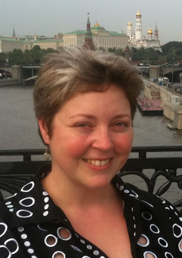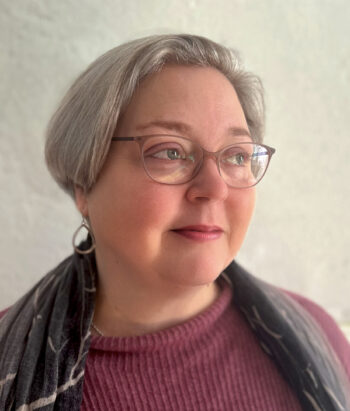[As part of our mission to look at storytelling in every medium, Storyboard is pleased to introduce Julia Barton, who will bring us several posts in 2012 focused on developments in and examples from the world of audio narratives. –Ed.]
Writers and video producers live in dread of the wandering eye. Audio producers live for it. That’s what makes us, in our secret hearts, troublemakers. We want you to lose sight of everything in front of your face: to stare through that dish in your hand, ignore your children, drop into a glazed-over trance of our making. Maybe don’t drive off the road, but please do miss a few exits or get stuck in your car. Good audio should be dangerous that way.
But it’s very hard to accomplish, especially these days, when more and more audio comes to us via that distraction machine, the Web. Hence these posts. In the Storyboard spirit, I’ll be talking with audio producers and editors about how they accomplish their best stories, what obstacles they’ve overcome and the strategies they’ve learned along the way. I should point out that conversations about audio craft have long been underway on sites like Transom and airmedia.org. And there’s a great new podcast, “How Sound,” from longtime audio instructor Rob Rosenthal, who also interviews intrepid producers. In the posts I’ll be doing for Storyboard, I’ll simply be adding to (and sometimes echoing) all those worthy explorations.
 I got my start in radio in 1995, while pursuing a master’s degree in nonfiction writing at the University of Iowa. Doing airshifts at WSUI, the university’s then-analog AM public radio station, was for me just an amusing side trip on the way to a blurry future in magazine writing. But then we started airing a new show, “This American Life,” at 6 a.m. on my Sunday shift. I had a huge list of things to do during that hour, but I kept forgetting about my impending newscast and listening to the radio instead. The stories, at once mesmerizing and funny and surprising, actually endangered my work. So I had to start putting TAL on cassettes to hear later, like a portable, or pocket – or what’s the word? – cast.
I got my start in radio in 1995, while pursuing a master’s degree in nonfiction writing at the University of Iowa. Doing airshifts at WSUI, the university’s then-analog AM public radio station, was for me just an amusing side trip on the way to a blurry future in magazine writing. But then we started airing a new show, “This American Life,” at 6 a.m. on my Sunday shift. I had a huge list of things to do during that hour, but I kept forgetting about my impending newscast and listening to the radio instead. The stories, at once mesmerizing and funny and surprising, actually endangered my work. So I had to start putting TAL on cassettes to hear later, like a portable, or pocket – or what’s the word? – cast.
Since those days, I’ve been a radio reporter, an editor, and contributor to such programs as PRI’s “Studio 360” and “The World.” Still, every time I sit down to craft a new audio feature, it feels almost as hard as the first time. Every piece is its own hellish puzzle.
That said, audio – especially broadcast radio – is a pretty conservative medium. Listeners appreciate familiarity and tend to punish experimentation (see below for one example). On the upside, I really don’t have to try anything new. On the downside: well, not to offend anyone, but there are plenty of places on the low FM band where, format wise, it remains 1979. That’s fine for many; I don’t want it to be fine for me.
So I sometimes go in search of the subtle shifts that amount to major trends in our hidebound world of audio storytelling. To that end, I talked with two people with their ears especially open: Julie Shapiro, the Artistic Director* of the Third Coast International Audio Festival (TCIAF) in Chicago, and Roman Mars, who was a judge for TCIAF’s awards competition this year – and who produces a successful and innovative podcast of his own, “99% Invisible,” about design. (Full disclosure: I’ve edited Roman’s work and also did a story for him).
Hundreds of aspiring Next-Big-Thing audio producers submit their best work to TCIAF from around the world. When I asked Shapiro and Mars what trends they’re hearing, most of their answers fell under one surprisingly simple category: the “Radiolab” Effect. WNYC’s “Radiolab,” in case you haven’t heard it, is an occasional broadcast and regular podcast about science, and it’s as highly produced as anything on the radio. Most “Radiolab” stories are crafted from hundreds of hours of audio, a ratio that that’s hard for even the most accomplished programs to pull off. Ira Glass recently confessed in Transom, “If they could do an hour of this every week, I think I’d have to quit radio.”
So Shapiro and Mars aren’t hearing a replication of of Radiolab’s labor-intensive production values, but they are hearing another trademark of the show, its conversational style. You’d think, since the talk radio format is mostly talk, that this would be a given. But radio evolved in the age of oratory, when a stentorian delivery helped pierce the broadcast static, and that’s what listeners still expect.
In the age of HD and earbuds, though, producers are finding they can sound more like themselves. “Radiolab” co-hosts Jad Abumrad and Robert Krulwich break down complicated stories through a relaxed Socratic dialogue, an approach that’s also been popularized by NPR’s “Planet Money” and APM’s “Freakonomics.”
“People are starting to recognize you can have fun and talk about interesting things as well,” Shapiro says. Or as Mars puts it, “In America, we explain things a lot. So much that we need two people.”
Shapiro and Mars also hear a big “Radiolab” Effect in the deeper integration of music and storytelling, far beyond the musical scoring that’s a hallmark of “This American Life.” You can hear Jad Abumrad’s Oberlin music composition degree in the show’s use of original music to explain concepts (this segment from the episode “Loops” is a good example). That technique is showing up in more TCIAF award winners, like this independent piece, “Kohn,” about a man with a disability that causes him to speak slowly but also causes his brain to hear himself as speaking like everyone else. Producer Andy Mills reached out to the band Hudson Branch to compose a song about Kohn’s brain, and the spoken story acts almost as a setup for the performance.
TCIAF’s winning story this year, “The Wisdom of Jay Thunderbolt,” takes the musical approach a step further, remixing whole swaths of an interview with an underworld character who runs (or ran) a strip club out of his Detroit home. The nervous, disorienting result crystallizes at the point when Thunderbolt pulls a gun on his interviewers.
“None of us could stop listening,” Mars says of the piece. “It solved problems in really creative ways. Almost every step was chancy.”
“Chancy,” of course, thrills the veteran producers behind TCIAF, and it’s their job to reward it. Yet flagship programs such as NPR’s “All Things Considered” get a lot of flack when they showcase even mildly risky work. So it’s to the show’s credit that it teamed up with the independent producers at Long Haul Productions to air their story about the relationship between hydraulic fracking and earthquakes in rural Arkansas. The piece breaks many formats: it’s non-narrated, meaning interviewees and “found sound” do all the talking; and it features a commissioned song interwoven among the interviews. Listeners were quick to vent their fury at NPR. “I don’t want artsy, stylistic reporting; I want factual reporting,” said one.
“How Sound” podcaster Rob Rosenthal later interviewed the producers, Dan Collison and Elizabeth Meister, about the experience. The upshot? It sucked, but ATC’s editors are standing by the team, and maybe next time they’ll make more effort to explain experimental formats ahead of time.
At least the angry ATC listeners were, well, listening. And maybe catching a whiff of how dangerous that can be.
*Julie Shapiro was initially described as the head of the Third Coast International Audio Festival. Her title has been corrected to Artistic Director.


